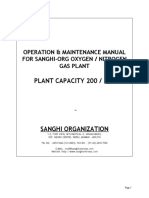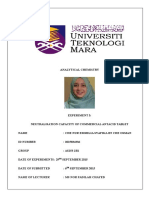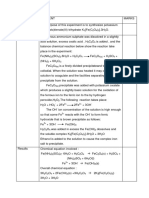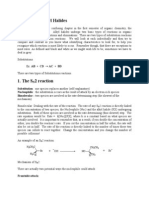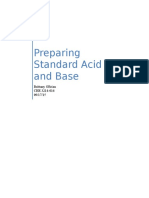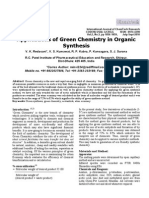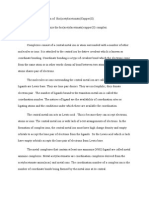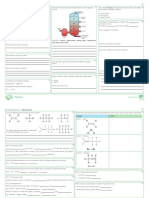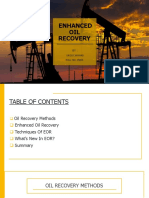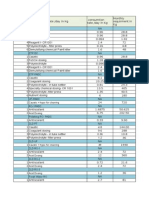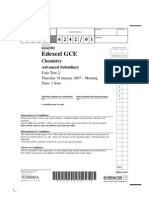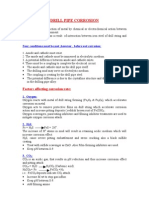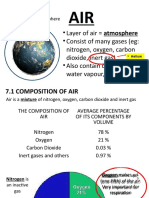Preparation of Acetaline Notes PDF
Preparation of Acetaline Notes PDF
Uploaded by
Anonymous Wwxatt3oIKCopyright:
Available Formats
Preparation of Acetaline Notes PDF
Preparation of Acetaline Notes PDF
Uploaded by
Anonymous Wwxatt3oIKOriginal Title
Copyright
Available Formats
Share this document
Did you find this document useful?
Is this content inappropriate?
Copyright:
Available Formats
Preparation of Acetaline Notes PDF
Preparation of Acetaline Notes PDF
Uploaded by
Anonymous Wwxatt3oIKCopyright:
Available Formats
CHEM 2423 Preparation and Recrystallization of Acetanilide
Dr. Pahlavan
EXPERIMENT 5 - Preparation of Acetanilide
Preparation and purification of Acetanilide
Purpose:
a) To synthesis acetanilide by reaction of aniline and acetic anhydride.
b) To purify acetanilide by crystallization method from water
c) Purity check by melting range
Equipment / Materials and Hazars:
hot plate
beakers(250, 400 mL)
Bchner funnel
rubber tubing (hose)
aniline
acetic anhydride
Acetanilide
FW
MP (BP)
(g/mol)
135.17 114 C
Aniline
93.13
Acetic Anhydride
102.09 (138 C)
(184 C)
stirring rod
weighing paper
filter paper
10- mL graduated cylinder large test tube
Compound
ice
spatula
digital scales
Mel-temp apparatus
medicine dropper
density
Hazards
---
Irritant. Harmful if inhaled/ingested.
Irritant (eyes/skin). Harmful if
1.022 g/mL
inhaled/ingested. Possible carcinogen.
Irritant (eyes/skin). Toxic by inhilation,
1.082 g/mL
Flammable (fp 49 C).
Discussion:
Recrystallization is a widely-used technique to purify a solid mixture. The desired product is
isolated from its impurities by differences in solubility. Insoluble impurities and colored
impurities can be removed from hot solvent through the use of activated carbon and filtration.
Soluble impurities remain in the cold solvent after recrystallization. The desired product should
be as soluble as possible in hot solvent and as insoluble as possible in cold solvent. The selection
of solvent is, therefore, critical to the successful recrystallization.
Recrystallization is a purification procedure, which requires solubility of the impure solid in a
heated solution and crystallization of the solid upon cooling. Clearly, this operation depends
upon solute-solvent in traction involving a number of parameters including concentration,
polarity of solute and solvent (like dissolves like), etc.
1
CHEM 2423 Preparation and Recrystallization of Acetanilide
Dr. Pahlavan
Choice of a solvent or solvent pair for recrystallization experiments generally involves
preliminary tests using a small sample and various solvent systems. To determine the proper
solvent or solvent system, the following steps are commonly performed.
I)
II)
III)
IV)
V)
VI)
The crude crystals should have low solubility in the chosen solvent at room
temperature.
The crude crystals should have high solubility in the chosen solvent when heated to
boiling.
The crude crystals should not react with the solvent
The solvent should boil at temperature below the solid melting point.
The solvent should moderately be volatile so crystals dried readily.
The solvent should be non-toxic, non-flammable, and inexpensive
The procedure illustrated in this experiment involve recrystallization, gravity filtration, suction
filtration, melting and mixture melting points, as well as calculations of theoretical and
percentage yields.
Gravity-filtration utilizes a fluted filter paper in the decolorizing or recrystallization step. In
gravity filtration, generally the filtrate is the desired material, which is used further in the
experiment.
In suction filtration, a Bchner funnel is employed to collect the desired crystals resulting from
a reaction or recrystallization attempt. Be sure to wet the filter paper with the solvent/solid
mixture to be filtered. When performing a suction filtration, it is usually advisable to install a
trap between the aspirator and the suction flask. In any case always break the vacuum before
turning the water off. In this operation, the filtrate or mother liquor may be concentrated to
obtain a second crop, etc. ( or may be disposed- consult with you instructor).
This experiment involves four functional groups common in organic chemistry. The substrate
(reactants) are both liquids and one of the products is solid. The reaction of aniline with acetic
anhydride is a transformation in which products, acetanilide and acetic acid, are obtained. A
solid product is often desirable since it may be recrystallized and a melting point determined.
Solids prepared in this manner serve a derivative, whose melting point may be correlated with
known values and thus is a means of identification and serves as a test for homogeneity or purity.
aniline, C6H7N
acetic anhydride
acetanilide, C8H9NO
acetic acid
CHEM 2423 Preparation and Recrystallization of Acetanilide
Dr. Pahlavan
Experimental Procedures
Using a medicine dropper, place 0.15 to 0.20 g of aniline (about 10 drops) (d = 1.02 g/ml) in a
large tared test tube and determine the weight to the nearest mg. Add 5 ml of distilled water to
the test tube and then add 20 drops of acetic anhydride again using a medicine dropper (Fig.1).
stir, the mixture using stirring rod for 5 minutes until solid forms.
Fig. 1 10 mL graduate cylinder and large test tube
The product crystallized in the same test tube. Add 5 ml of water and heat the test tube in a hot
water bath ( 400 mL beaker) (Fig.2) with occasional stirring until the entire solid dissolved. Set
the test tube aside to cool for 3-5 minutes and then chill it in an ice bath. When crystallization is
complete, collect the product by vacuum filtration using a small Bchner funnel (Fig.3). Allow
the sample to dry completely. Weigh the dry product, calculate the percentage yield and
determine its melting point. Collect to product in a paper and write your name and submit it to
your instructor. The aqueous filtrate may be flushed down the drain.
acetanilide
Buchner
funnel
vacuum(suction)
filtrate
Fig. 2 Hot water bath
Fig. 3 Bchner funnel and suction flask
mass acetanilide recovered
% Yield acetanilide =
x100
theoretical mass of acetanilide
Note: Submit product to the instructor in a properly labeled container.
3
CHEM 2423 Preparation and Recrystallization of Acetanilide
Laboratory EXP 5
Dr. Pahlavan
Name:
Data and Results (Preparation and Purification of Acetanilide)
Date:____________
Lab Report: _______
1. Sample name ________________________
2. Data on the impure sample
a. Mass of the aniline + test tube + beaker
________ g
b. Mass of the aniline + test tube
________ g
c. Mass of aniline
________ g
d. Mole of aniline
________ mol
e. Theoretical moles of Acetanilide
________ mol
f. Theoretical mass of acetanilide
________ g
(show calculation)
3. Data for recrystallized acetanilide
a. Mass of recrystallized acetanilide + Weighing paper
________g
b. Mass of recrystallized acetanilide
________g
c. Calculation of percentage recovery
(show calculation)
________%
d. Melting point of recrystallized acetanilide
e. Structural formula of the sample recrystallized
________ oC
CHEM 2423 Preparation and Recrystallization of Acetanilide
Pre-Laboratory QuestionsEXP 5
Dr. Pahlavan
Name:
Due before lab begins. Answer in space provided.
1. A hot solution of a particular compound was allowed to cool to room temperature. After
waiting a few minutes, it was noticed that the crystallization had not taken place. Discuss two
ways to induce crystallization.
2. What properties are necessary and desirable for a solvent in order that it is well suited for
recrystallizing a particular organic compound?
3. Assume that 3.0 g of aniline and 4.5 ml of acetic anhydride are used in the preparation of
acetanilide. What is the limiting reagent? What is the theoretical yield of acetanilide? What is?
the percentage yields if 3.3 g of acetanilide is obtained?
4. The solubility of compound A in ethanol is 0.4 g per 100 ml at 0oC and 5.0 g per 100 ml
at 75 oC. What is the minimum amount of solvent needed to recrystallize an 8.0 g sample of
compound A? How much would be lost in the recrystallization?
5. Impure acetanilide was dissolved in hot water. The solution was filtered hot and the beaker of
solution was immediately placed in an ice-water bath instead being allowed to cool slowly.
What will be the result of cooling the solution in this manner?
CHEM 2423 Preparation and Recrystallization of Acetanilide
Post-Laboratory QuestionsEXP 5
Dr. Pahlavan
Name:
Due after completing the lab.
1. During recrystallization, an orange solution of a compound in hot alcohol was treated with
activated carbon and then filtered through fluted paper. On cooling, the filtrate gave gray
crystals, although the compound was reported to be colorless. Explain why the crystals were
gray and describe steps that you would take to obtain a colorless product.
2. The solubility of acetanilide in hot water (5.5 g/100 ml at 100 oC) is not very great, and its
solubility in cold water (0.53 g/ 100 ml at 0 oC) is significant. What would be the maximum
theoretical percent recovery from the crystallization of 5.0 g of acetanilide from 100 ml water.
(assuming the solution is chilled at 0 oC).
3. If your experiment yield of acetanilide is greater than 100%, how could this occur?
4. Describe how would you separate a mixture of acetanilide and sand.
5. Why is fluted paper usually used when doing hot filtration during recrystallization?
You might also like
- Plant Capacity 200 / 300: Operation & Maintenance Manual For Sanghi-Org Oxygen / Nitrogen Gas PlantDocument51 pagesPlant Capacity 200 / 300: Operation & Maintenance Manual For Sanghi-Org Oxygen / Nitrogen Gas PlantEdduin Rodriguez100% (5)
- Relative Reactivities of Several Aromatic CompoundsDocument9 pagesRelative Reactivities of Several Aromatic CompoundsSimranjit KaurNo ratings yet
- Experiment 3 Redox Titration Percent Purity AnalysisDocument5 pagesExperiment 3 Redox Titration Percent Purity AnalysisnanaNo ratings yet
- Determination of Fluoride Concentration Using Ion Selective ElectrodeDocument7 pagesDetermination of Fluoride Concentration Using Ion Selective ElectrodeAmanda WangNo ratings yet
- (Martin Ferrier Young BSC (Hons Phys) BSC (Chiroprac (B-Ok - CC) PDFDocument271 pages(Martin Ferrier Young BSC (Hons Phys) BSC (Chiroprac (B-Ok - CC) PDFCristian TricaNo ratings yet
- Ig 02Document5 pagesIg 02Johan Sebastian Pantoja MuñozNo ratings yet
- Gravimetric Determination of Moisture CoDocument5 pagesGravimetric Determination of Moisture CoDEFIN BIMA REYNANDANo ratings yet
- Gravimetry Lab Report Experiment 01Document4 pagesGravimetry Lab Report Experiment 01PDPPPMAT0621 Ruhilin Binti NasserNo ratings yet
- Aldol Condensation Between Benzaldehyde and AcetoneDocument5 pagesAldol Condensation Between Benzaldehyde and Acetonevicky_law_2No ratings yet
- BENG0015 - Distilation Exam QuestionsDocument6 pagesBENG0015 - Distilation Exam QuestionsHercules ArgyNo ratings yet
- Axens Portfolio of Selective Hydrogenation Catalysts - Imp - RectoDocument11 pagesAxens Portfolio of Selective Hydrogenation Catalysts - Imp - RectovijaymwaghNo ratings yet
- Laboratory Report of Melting PointDocument5 pagesLaboratory Report of Melting PointHanna Anne88% (8)
- CHM 212 Experiment 5 - Gravimetric Determination of Calcium As ...Document2 pagesCHM 212 Experiment 5 - Gravimetric Determination of Calcium As ...Shante MorganNo ratings yet
- CE - Experiment 2 Extraction With Acid and AlkalineDocument8 pagesCE - Experiment 2 Extraction With Acid and AlkalineWeiChingNo ratings yet
- Di Benz Al AcetoneDocument3 pagesDi Benz Al AcetoneKristine Mae De GuzmanNo ratings yet
- Qualitative Analysis Formal Report - AlcoholsDocument3 pagesQualitative Analysis Formal Report - AlcoholsPrincess Alyssa Abid100% (1)
- CHM 421 Exp 3Document6 pagesCHM 421 Exp 3EmmiliaNo ratings yet
- Experiment 6Document7 pagesExperiment 6Jc GohNo ratings yet
- Synthesis of Potassium TrioxalatoaluminaDocument5 pagesSynthesis of Potassium TrioxalatoaluminaAndile ManyoniNo ratings yet
- CH425Document35 pagesCH425Vatra ReksaNo ratings yet
- Qualitative Organic Analysis - Sem 3Document37 pagesQualitative Organic Analysis - Sem 3Reshma SomanNo ratings yet
- Lab Report c1Document5 pagesLab Report c1Sumayyah100% (1)
- Lab 6 Using PH ElectrodeDocument14 pagesLab 6 Using PH ElectrodeMina VoNo ratings yet
- Experiment 3thermodynamic Functions and Solubility Product of Barium NitrateDocument9 pagesExperiment 3thermodynamic Functions and Solubility Product of Barium NitrateMay LeeNo ratings yet
- ADSORPTIONDocument6 pagesADSORPTIONSatyamGupta0% (1)
- Lab ReportDocument8 pagesLab ReportNAEEM MALIKNo ratings yet
- Aldol Condensation DiscussionDocument3 pagesAldol Condensation DiscussionDenisse Watt Cuarteros100% (8)
- Synthesis of Alkyl HalideDocument3 pagesSynthesis of Alkyl HalideKelvin LabarezNo ratings yet
- Experiment 3Document3 pagesExperiment 3Laura Maria Segundo100% (1)
- Lab CHM 457 Exp 2Document10 pagesLab CHM 457 Exp 2JohanNo ratings yet
- LAB GravimetricAnalysisSulfateMixtureDocument3 pagesLAB GravimetricAnalysisSulfateMixtureDNo ratings yet
- Chemistry 12 - Unknown Acid Base Titration LabDocument6 pagesChemistry 12 - Unknown Acid Base Titration LabarasurtNo ratings yet
- To Synthesize Potassium Tri Oxalato Ferr PDFDocument5 pagesTo Synthesize Potassium Tri Oxalato Ferr PDFApheleleNo ratings yet
- 3rd Seminar ReportDocument5 pages3rd Seminar Reportvaibhav palNo ratings yet
- The Fluoride Ion Selective Electrode ExperimentDocument5 pagesThe Fluoride Ion Selective Electrode Experimentlisaaliyo0% (1)
- Synthesis of Camphor PDFDocument4 pagesSynthesis of Camphor PDFJijia BaiNo ratings yet
- Neutralisation Capacity of Commercial Antacid TabletDocument6 pagesNeutralisation Capacity of Commercial Antacid TabletEmmilia25% (4)
- Alkanes & Alkenes: Combustion and Action of Sulphuric AcidDocument7 pagesAlkanes & Alkenes: Combustion and Action of Sulphuric AcidNg Sin HuiNo ratings yet
- Lab Manual Metal Acetylacetonate Complexes Web PDFDocument22 pagesLab Manual Metal Acetylacetonate Complexes Web PDFYan Jie ChongNo ratings yet
- Aspirin Synthesis Lab Report PDFDocument11 pagesAspirin Synthesis Lab Report PDFRobbyNo ratings yet
- Prep of 2 Chloro 2 MethylpropaneDocument4 pagesPrep of 2 Chloro 2 MethylpropaneEmy AB50% (2)
- Lab1 3Document5 pagesLab1 3Izzat Arif33% (3)
- Reactions of Alkyl HalidesDocument12 pagesReactions of Alkyl HalidesDarwin MangabatNo ratings yet
- Preparing Standard Acid and BaseDocument7 pagesPreparing Standard Acid and Basebrittany obrienNo ratings yet
- Experiments 3,4,5Document13 pagesExperiments 3,4,5Athirah JamalludinNo ratings yet
- Objectives: FIGURE A: Example of Coordination CompoundsDocument7 pagesObjectives: FIGURE A: Example of Coordination CompoundsNurul izzatiNo ratings yet
- Chm421-Experiment 3 - Neutralization Capacity of CommercialDocument9 pagesChm421-Experiment 3 - Neutralization Capacity of Commercialnipale hiNo ratings yet
- Carboxylic Acid Lab ReportDocument7 pagesCarboxylic Acid Lab Reportretsen30002No ratings yet
- Title: Preparation of 4-MethylcyclohexeneDocument7 pagesTitle: Preparation of 4-MethylcyclohexeneNur AthirahNo ratings yet
- Acetanilide Green ChemDocument4 pagesAcetanilide Green Chemconker4No ratings yet
- Organic Chemistry Laboratory I BSK1402 Lab Report: Name Fathul Aiman Bin Fahmi Matrix No. Sa18094 Section 02 DateDocument8 pagesOrganic Chemistry Laboratory I BSK1402 Lab Report: Name Fathul Aiman Bin Fahmi Matrix No. Sa18094 Section 02 DateCucu AlbertNo ratings yet
- Ochem 13Document2 pagesOchem 13IzzyNo ratings yet
- Formal LabDocument4 pagesFormal Labljeanja2100% (1)
- Lab Report#3 Carbohydrate Test - Fehling's TestDocument3 pagesLab Report#3 Carbohydrate Test - Fehling's Testohmyveenus617No ratings yet
- Experiment 1: Calibration of A Volumetric FlaskDocument5 pagesExperiment 1: Calibration of A Volumetric FlaskNur Faizatul AtiqahNo ratings yet
- Synthesis of An Alkyl HalideDocument4 pagesSynthesis of An Alkyl HalideJoseph CatiisNo ratings yet
- Exp 6Document8 pagesExp 6KaVisha AShaNo ratings yet
- Synthesis of Ethyl AcetateDocument7 pagesSynthesis of Ethyl AcetateTanChantreaNo ratings yet
- Chemical Reaction Kinetics: Concepts, Methods and Case StudiesFrom EverandChemical Reaction Kinetics: Concepts, Methods and Case StudiesNo ratings yet
- Experiment 5 - : Preparation and Purification of AcetanilideDocument6 pagesExperiment 5 - : Preparation and Purification of AcetanilideFluoruro De PotasioNo ratings yet
- RecrystalizationDocument5 pagesRecrystalizationapi-307642367No ratings yet
- Final Report Experiment 2Document6 pagesFinal Report Experiment 2Jhei Mesina AfableNo ratings yet
- Observations:: Lab Report For Experiment #2: Purification of Acetanilide by RecrystallizationDocument2 pagesObservations:: Lab Report For Experiment #2: Purification of Acetanilide by RecrystallizationJV GamoNo ratings yet
- Summative Test 1st Quarter Smaw NciiDocument8 pagesSummative Test 1st Quarter Smaw NciiWilson Jan AlcopraNo ratings yet
- Gross Heat in Petroleum Coke: Instrument: AC600Document2 pagesGross Heat in Petroleum Coke: Instrument: AC600Alfredo MarcanoNo ratings yet
- INTERNSHIPDocument9 pagesINTERNSHIPVaishnavi zoreNo ratings yet
- Topic 7 Organic Chemistry Revision MatDocument6 pagesTopic 7 Organic Chemistry Revision MatMireiaNo ratings yet
- Atmospheric Distillation of Crude OilDocument2 pagesAtmospheric Distillation of Crude OilAnonymous FGzDAs0SoNo ratings yet
- Adiabatic Flame TemperatureDocument5 pagesAdiabatic Flame TemperatureRaghav SharmaNo ratings yet
- Enhanced Oil RecoveryDocument17 pagesEnhanced Oil Recoveryurooj jawwad100% (1)
- Pipeline Pigging: An Innovative Concept in Pipe Cleaning Pipeline Pigging: An Innovative Concept in Pipe CleaningDocument8 pagesPipeline Pigging: An Innovative Concept in Pipe Cleaning Pipeline Pigging: An Innovative Concept in Pipe CleaningdrinkwaterproductsNo ratings yet
- Western Innovator 2013Document52 pagesWestern Innovator 2013Agustin CesanNo ratings yet
- Chemical ListDocument1 pageChemical ListKrunal Bhosale0% (1)
- Boiler Feedwater: History of Feedwater TreatmentDocument6 pagesBoiler Feedwater: History of Feedwater Treatmentmhd_bashiriNo ratings yet
- Atmospheric Distillation UnitDocument3 pagesAtmospheric Distillation UnitGilles DakouriNo ratings yet
- References Middle EastDocument33 pagesReferences Middle EasthayyanNo ratings yet
- Excess Air OptimizationDocument9 pagesExcess Air OptimizationJunaid MazharNo ratings yet
- Absorption Refrigerator - WikipediaDocument5 pagesAbsorption Refrigerator - Wikipediaaravind grandhiNo ratings yet
- Chemistry ProjectDocument14 pagesChemistry ProjectBala Prasanna0% (2)
- GGSPL Corporate PresentationDocument10 pagesGGSPL Corporate PresentationpduvvuriNo ratings yet
- To Study The Global Market Scenario and Analyze New Apllications of Industrial GasesDocument16 pagesTo Study The Global Market Scenario and Analyze New Apllications of Industrial GasesSamuel DavisNo ratings yet
- ROSE® Process Offers Energy Savings For Solvent ExtractionDocument14 pagesROSE® Process Offers Energy Savings For Solvent Extractiona_abbaspourNo ratings yet
- Amine Gas Sweetening Sulphur RecoveryDocument4 pagesAmine Gas Sweetening Sulphur RecoveryBayu Saputra100% (1)
- 6242 01 Que 00070118Document16 pages6242 01 Que 00070118a盈仪No ratings yet
- Algiers Arzew Ighil IzanDocument1 pageAlgiers Arzew Ighil Izannadji12No ratings yet
- Iso 8217 2010 Fuel Standard: For Marine Distillate FuelsDocument2 pagesIso 8217 2010 Fuel Standard: For Marine Distillate FuelsMarco MeloniNo ratings yet
- Drill Pipe CorrosionDocument2 pagesDrill Pipe Corrosionfbiagent008No ratings yet
- AGRU SystemDocument1 pageAGRU SystemNoar CaesarNo ratings yet
- 2019 Air f1 NewDocument36 pages2019 Air f1 NewAnonymous hf5smN4FNo ratings yet
- Welder'S Performance Record: Rejection Rate (%) Rejected Total Welded Tested AcceptedDocument3 pagesWelder'S Performance Record: Rejection Rate (%) Rejected Total Welded Tested AcceptedJeniffer Sta. MariaNo ratings yet
